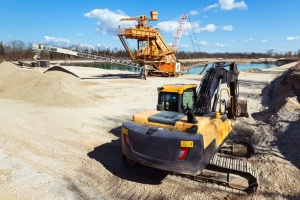With the advancement of technology, modern grading and excavation techniques help optimize construction, ensuring precision, efficiency, and durability. This article delves into the most recent developments and their advantages to better understand how these methods affect manufacturing projects.

Understanding Grading and Excavation
Before diving into advanced techniques, it’s important to understand what grading and excavation involve and why they are necessary for industrial sites.
What is Grading?
Grading refers to shaping and leveling the ground to create a stable surface for construction. It involves cutting high areas and filling low spots to achieve the required elevation. This process helps improve drainage, prevent soil erosion, and provide a strong base for structures.
What is Excavation?
Excavation is the process of digging and removing soil, rocks, or debris to create space for building foundations, roads, pipelines, and other infrastructure. Excavation is essential for underground utilities, stormwater management, and site leveling.
For industrial sites, high-accuracy grading and excavation are absolutely necessary to guarantee stability, safety, and economy of cost.
Key Techniques in Grading and Excavation
With the rise of advanced machinery and technology, grading and excavation have become more precise and efficient. Here are some of the top techniques used in modern industrial site preparation:
1. Laser-Guided Grading
Laser-guided grading levels the land very accurately by using laser technology. A laser transmitter sends a signal to a grading machine’s receiver, which lets the operators change the blade height right away.
✅ Benefits:
- Ensures smooth and even surfaces
- Reduces material waste
- Improves drainage and foundation stability
This method is widely used in industrial sites where precision is crucial for large-scale construction.
2. GPS-Controlled Excavation
GPS technology has transformed excavation by enabling machine operators to dig with extreme accuracy. With GPS-guided equipment, operators can follow digital site plans displayed on a screen, reducing the need for manual staking.
✅ Benefits:
- Minimizes errors and over-excavation
- Reduces fuel and labor costs
- Speeds up project completion
This technique is especially useful for digging trenches for utilities and creating foundations for heavy structures.
3. Soil Compaction for Stability
After grading and excavation, soil compaction is necessary to strengthen the ground. Heavy rollers and compactors are used to press down loose soil, increasing its density and load-bearing capacity.
✅ Benefits:
- Prevents foundation settling and cracks
- Enhances ground stability for heavy industrial buildings
- Improves soil drainage
Proper soil compaction ensures that the ground can support large warehouses, factories, and roadways without sinking or shifting.
4. Erosion Control Methods
Erosion can cause significant problems for industrial sites, leading to soil loss, drainage issues, and structural instability. Modern erosion control techniques include:
- Silt Fencing: Keeps the soil from washing away while the building is going on.
- Hydroseeding: Sprays a mixture of seeds, mulch, and nutrients to stabilize the soil.
- Retaining Walls: Supports slopes and prevents landslides.
✅ Benefits:
- Protects the environment and nearby waterways
- Maintains soil integrity for long-term stability
- Reduces maintenance costs after construction
Controlling erosion is important for places with loose soil, slopes, or exposure to heavy rain.
Benefits of Precision Grading and Excavation
Using advanced techniques in grading and excavation leads to several advantages for industrial construction:
1. Stronger and More Stable Foundations
A site that has been properly graded and excavated guarantees a strong foundation for infrastructure and buildings. This lowers the possibility of future structural damage and expensive repairs.
2. Cost Efficiency and Reduced Waste
With precise grading and excavation, construction companies can avoid unnecessary digging, soil movement, and material waste. This leads to significant cost savings on labor, fuel, and materials.
3. Faster Construction Timelines
Modern technology allows grading and excavation to be completed faster and with fewer errors. GPS and laser-guided equipment eliminate the need for manual adjustments, speeding up the entire process.
4. Environmental Protection
Damage to the landscape, soil displacement, and water runoff pollution are all avoided with proper grading and erosion control techniques. This aids businesses in maintaining sustainability and adhering to environmental laws.
Challenges and Solutions in Grading and Excavation
Despite the advancements in technology, grading and excavation still come with challenges. Here’s how they can be addressed:
1. Dealing with Unstable Soil
Some industrial sites have weak or loose soil that cannot support heavy structures. To solve this:
✅ Solution: Use soil stabilization techniques, such as adding gravel, lime, or geotextiles, to strengthen the ground.
2. Weather-Related Delays
Rain, snow, or extreme heat can slow downgrading and excavation.
✅ Solution: Plan activities in line with the seasons and apply drainage systems and tarps as protective measures.
3. Equipment Limitations
Older or outdated equipment may not provide the precision required for modern construction.
✅ Solution: Invest in GPS and laser-guided machinery to improve accuracy and efficiency.
Conclusion
Any industrial building project’s foundation is grading and excavation. By using advanced techniques such as laser-guided grading, GPS-controlled excavation, soil compaction, and erosion control, construction companies can achieve precision, efficiency, and long-term stability.
These techniques guarantee that industrial sites stay safe and ecologically friendly in addition to saving time and money. A successful and long-lasting construction for any industrial project depends on investing in contemporary grading and excavation methods.
If you’re planning an industrial site project, contact us to consult experts in grading and excavation for the best results.


